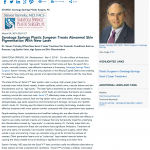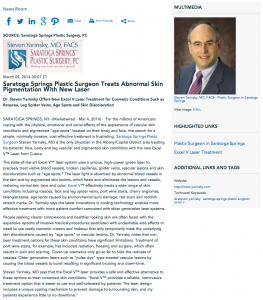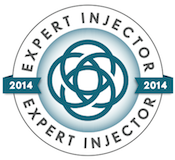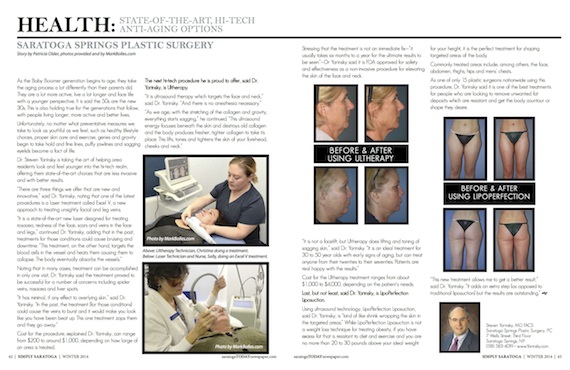Home | 2014
2014
Introducing truSculpt™!


If you’re at or near your ideal weight, but still struggling with stubborn deposits of fat, our newest addition to the office may be just what you are looking for. truSculpt™ utilizes radiofrequency in order to reduce fat in a non-surgical, non-invasive way, on multiple areas of the body. Patients have three treatments, and can see visible reduction of fat within four weeks of their final treatment, with maximum results achieved twelve weeks after final treatment.
truSculpt™ can easily be combined with other of our non-surgical or minimally invasive treatments in order achieve optimal cosmetic results.
To learn more about this revolutionary new procedure or to schedule a consultation at our Joint Commission accredited facility, please contact our office.
Practice Safe Skin & Prevent Aging – Looking Younger the Easy Way


Routine use of sunscreen not only helps to prevent skin cancer (currently an international epidemic with the depletion of the ozone layer) but helps to prevent aged skin. As a cosmetic plastic surgeon I consult patients daily to evaluate where they are in the aging process and what can be done to help them regain and maintain their youthful appearance. The four major things which make people look older are gravity effects, hyperactive facial muscles, loss of facial bone volume and last, but not least, skin surface changes- the “icing on the cake”.
Sun and artificial tanning destroys skin elasticity, and creates thickened skin with deeper pores, discoloration and wrinkle lines which all lead to an aged appearance. So an easy up-front fix at younger ages is to avoid facial tanning, prevent sunburns, and to use protective clothing (wide-brimmed hat) and sunscreens. Remember that a tan equals skin damage. A summary of “The Truth About Sunscreen” in the July 2014 issue of Consumer Reports follows. SPF is the “Sun Protective Factor” and is the number which divided into 60 indicates how many minutes of unprotected sun ultraviolet B ray (UVB) exposure you would receive in an hour under the sun if you have the sunblock correctly applied to your skin. For instance using an SPF 30 sunscreen during an hour of sun exposure should equal only 2 minutes of exposure without using protection. An SPF 30 provides 97% of UVB protection; SPF 50- 98%; SPF 100-99%. So there is not great need to spend a great deal more on sunscreens rated above SPF 50. In fact the FDA may eventually limit sunscreen labeling to not allow those above SPF 50.
But here are the problems with sunscreens:
1) The U. S. Food and Drug Administration (FDA) is the Federal Government consumer product and drug regulatory agency. The FDA has not tested sunscreens for accuracy of the SPF numbers. Nor does it test for accuracy of the terms “broad-spectrum” (which means UVA and UVB light ray protection) and for “water-resistance” of these products. Although ultraviolet B rays (UVB) are most implicated in sunburn, skin damage and skin cancer, ultraviolet A rays (UVA), which penetrate deeper, can cause signs of premature skin aging, and contribute to the development of Melanoma.
2) The FDA does not make a distinction between sunscreens marketed for use on children or adults. Often the ingredients in each were found to be identical. Some kids’ sunscreens are formulated to be mild, sting-free and tear-free but adult sunscreens may also share these gentler characteristics. The bottom line- use a sunscreen that does not irritate your skin. If you develop a rash with use, try another from the recommended list.
3) You need to use enough sunscreen to make it work. It takes about 2 tablespoons to properly cover your face and body (less in small children). This amount should be applied at least 15 minutes before sun exposure and reapplied every 2 hours (even when using those sunscreens that claim to last longer or are “water resistant”). Most people apply an inadequate amount of sunscreen which will not be effective. A little does not go a long way.
4) “Natural” and “chemical” containing sunscreens are equally safe to use. Mineral based zinc oxide and titanium oxide ingredients are often listed as “natural” because these are mined from the earth, but they are highly purified and processed and often are coated with other chemicals in the processing. However, some sunscreens use “clear” (instead of white-colored) versions of titanium and zinc which are broken down into nanoparticles. Nanoparticles may be absorbed through the skin and there is some controversy about their health effects.
5) Although there seem to be many more spray sunscreens being sold than in prior years, there is no advantage to using spray over sunscreen lotions. In fact, sprays may blow away from your body while being applied leading to much less protection. Consumer Reports recommends holding the nozzle 4-6 inches from the skin and rub in after applying. Spray each area twice to prevent missing skin surfaces. Also- avoid spraying your face (spray your hand and apply from your hand to cover your face) to prevent inhaling spray sunscreen. Inhaling spray can irritate your lungs and inhaled titanium dioxide may cause cancer! Let the spray sunscreen dry before going near flames (the grill). While wet, the spray may catch fire and burn you. The FDA is still evaluating spray safety and effectiveness.
6) While sunscreens may be labeled water resistant, the FDA no longer allows manufacturers to use the terms “waterproof, sweat proof or sunblock”. Those sunscreens who claim water resistance must be labeled with how long the listed SPF protection will last when sweating or swimming. The FDA only allows them to list 40 or 80 minutes. No brands are allowed to claim effectiveness beyond two hours- the recommended time to reapply all sunscreens.
The FDA recommends avoiding tanning and practicing “safe skin” using the following guidelines:
Spending time in the sun increases the risk of skin cancer and early skin aging. To reduce this risk, consumers should regularly use sun protection measures including:
- Use sunscreens with broad spectrum SPF values of 15 or higher regularly and as directed.
- Limit time in the sun, especially between the hours of 10 a.m. and 2 p.m., when the sun’s rays are most intense.
- Wear clothing to cover skin exposed to the sun; for example, long-sleeved shirts, pants, sunglasses, and broad-brimmed hats.
- Reapply sunscreen at least every 2 hours, more often if you’re sweating or jumping in and out of the water.
So what sunscreen is best to buy and use?
According to the July 2014 Consumer Reports magazine of all sunscreens tested, the following are the best bets:
Lotions: Coppertone Water Babies SPF50 ($11.00; cost per ounce $1.38);
Equate (Walmart brand) Ultra Protection SPF50 ($9.00; cost per ounce $0.56)
Ultrahigh SPF Lotion: Neutrogena Ultimate Sport SPF70+ ($11.00; cost per ounce $2.75)
Sprays: Bullfrog Water Armor Sport InstaCool ($10; cost per ounce $1.67)
Up & Up (Target) Sport SPF50 ($8.00; cost per ounce $0.80)
Well (Walgreens) Sport SPF50 ($9.50; cost per ounce $1.58)
Ultrahigh SPF Spray: Banana Boat Ultra Defense Max Skin Protect SPF110 ($10.50; cost per ounce $1.75)
Saratoga Springs Plastic Surgeon Treats Abnormal Skin Pigmentation with New Laser


Dr. Steven Yarinsky Offers New Excel V Laser Treatment for Cosmetic Conditions Such as Rosacea, Leg Spider Veins, Age Spots and Skin Discoloration.
Saratoga Springs, NY – For the millions of Americans coping with the physical, emotional and social effects of the appearance of vascular skin conditions and pigmented “age spots” located on their body and face, the search for a simple, minimally-invasive, cost-effective treatment is frustrating. Saratoga Springs Plastic Surgeon Steven Yarinsky, MD is the only physician in the Albany/Capital District area treating his patients’ face, body and leg vascular and pigmented skin conditions with the new Excel V™ Laser from Cutera.
The state-of-the-art Excel V™ laser system uses a unique, high-power green laser to precisely treat visible blood vessels, broken capillaries, spider veins, vascular lesions and skin discolorations such as “age spots.” The laser light is absorbed by abnormal blood vessels in the skin and by pigmented skin lesions, which heats and eliminates the lesions and vessels, restoring normal skin tone and color. Excel V™ effectively treats a wide range of skin conditions including rosacea, face and leg spider veins, port wine stains, cherry angiomas, telangiectasias, age spots caused by environmental (sun) damage, red scars and reddish stretch marks. Dr. Yarinsky says the latest innovations in cooling technology enables more effective treatment with more patient comfort compared with older generation laser systems.
People seeking clearer complexions and healthier looking skin are often faced with the expensive options of invasive medical procedures associated with undesirable side effects or need to use costly cosmetic creams and makeup that only temporarily mask the underlying skin discolorations caused by “age spots” or vascular lesions. Dr. Yarinsky notes that non-laser treatment options for these skin conditions have significant limitations. Treatment of port wine stains, for example, has included radiation, freezing and surgery, which often results in pain and scarring. Cover-up cosmetics only go so far to hide the redness of rosacea. Older generation lasers such as “pulse-dye” type treated vascular lesions by causing the blood vessels to burst resulting in significant bruising and down-time.
Steven Yarinsky, MD says that the Excel V™ laser provides a safe and effective alternative to these options to treat unwanted skin conditions. “Excel V™ provides a reliable, noninvasive treatment option that is easier to use and well-tolerated by patients. The laser design includes a unique cooling mechanism to prevent damage to surrounding skin, and my patients experience little to no downtime.”
Dr. Yarinsky has found patients to be very satisfied with the results. “One of my patients told me last week that before they received the Excel V™ treatment they were always self-conscious of the redness in their face and by their age spots. After the single treatment, they no longer needed to wear cover-up or camouflage cosmetics,” says Dr. Yarinsky. “They said that the treatment was easy and surprisingly comfortable,” he added.
Rather than a standard “boilerplate” treatment, Dr. Yarinsky says Excel V™ treatments are customized to suit each patient’s unique skin condition, and adjustments are made for different lesion and vessel depths and sizes, from superficial blemishes to deep vascular scars.
About Steven Yarinsky, MD, FACS
Dr. Steven Yarinsky earned his medical degree from SUNY Upstate Medical Center in Syracuse and went on to complete a 5-year general surgery residency at Ohio State University Hospital in Columbus and Marshall University Medical School. Dr. Yarinsky then completed training in Plastic and Reconstructive Surgery at the Medical College of Ohio. He puts a high value on medical education, which is why he spends more than 150 hours every three years continuing to learn new techniques and technologies. Dr. Yarinsky is a member of professional organizations including the American Society of Plastic Surgeons, the American Society for Aesthetic Plastic Surgery, the Northeastern Society of Plastic Surgeons, and the Medical Society of the State of New York. He is available for interview upon request.
For more information about treating vascular skin conditions and “age spots”, and Excel V™ laser system treatments, please contact Steven Yarinsky, MD. To learn more about Saratoga Springs Plastic Surgery, visit yarinsky.com or facebook.com/saratogaspringsplasticsurgery
Contact:
Saratoga Springs Plastic Surgery, PC
7 Wells Street
3rd Floor
Saratoga Springs, NY 12866
(518) 583-4019
Rosemont Media
[email protected]
(858) 200-0044
www.rosemontmedia.com
Dr. Yarinsky Featured in Simply Saratoga
Local publication Simply Saratoga featured Dr. Yarinsky and his Saratoga Springs Plastic Surgery practice in their Winter issue. Check out the article below:
Voluma Now FDA Approved
Juvéderm Voluma™ XC was introduced in the American market in December 2013 as the first and only FDA-approved filler for the midface. Facial aging is associated with loss of volume in the cheek region due to loss of bone, muscle and fat. The goal of cheek augmentation is to restore a natural-looking curve to your cheeks for a more youthful look. Dr. Koumanis is certified by Allergan, the manufacturer, to provide Juvéderm Voluma™ XC injections for cheek augmentation to correct age-related mid-face volume loss. Cheek augmentation with Juvéderm Voluma™ XC is a brief minimal down-time procedure with results that last up to 2 years.
What is an Expert Injector?
 Dr. Koumanis is the only Upstate New York and Capital District area physician to fully participate in Expert Injector, a group of highly skilled and trained plastic surgeons who specialize in administering facial fillers and muscle relaxants such as Botox® Cosmetic, Dysport® and Xeomin®. This combination of treatments results in a “liquid facelift” and can help you look 5 or 10 years younger without surgery! Each physician member of Expertinjector.org is dedicated to providing you with an exceptional level of quality, service, and care to achieve the best possible results with your facial and lip filler and muscle relaxant treatments all done in a safe environment using FDA –cleared injectables always purchased directly from the manufacturers. Dr. Koumanis personally performs all treatments himself to rejuvenate, restore and maintain your youthful appearance.
Dr. Koumanis is the only Upstate New York and Capital District area physician to fully participate in Expert Injector, a group of highly skilled and trained plastic surgeons who specialize in administering facial fillers and muscle relaxants such as Botox® Cosmetic, Dysport® and Xeomin®. This combination of treatments results in a “liquid facelift” and can help you look 5 or 10 years younger without surgery! Each physician member of Expertinjector.org is dedicated to providing you with an exceptional level of quality, service, and care to achieve the best possible results with your facial and lip filler and muscle relaxant treatments all done in a safe environment using FDA –cleared injectables always purchased directly from the manufacturers. Dr. Koumanis personally performs all treatments himself to rejuvenate, restore and maintain your youthful appearance.
